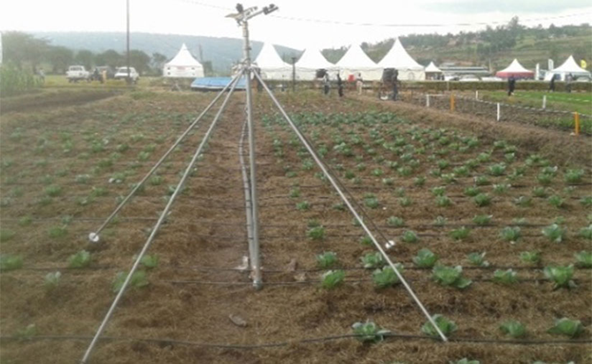Hillside irrigation
With irrigation farmers are able to have continuous crops and multiply production and income. Assessments of Rwanda irrigation potential indicates that the country has a national irrigation potential of nearly 600.000 ha, taking into consideration the following domains.
• Runoff for small reservoirs (125 627 ha)
• Runoff for dams (31 204 ha)
• Direct river and flood water (80 974 ha)
• Lake water resources (100 153 ha)
• Groundwater resources (36 434 ha)
• Marshlands (222 418 ha)
The category of marshland irrigation is described in the section on wetlands (link). Most practiced irrigation method is flood irrigation. The field is flooded with a layer of water and water inflitrates in the soil. This is used and adequate for rice and sugarcane cultivation in the valley bottoms. It is also practised on hillsides for foddercrops or crops on ridges while the water flows through the furrows.
However, more water efficient methodes and technologies are recommended. Drip irrigation is increasingly practiced with drip irrigation.. Water flows thourgh a hose with regular outlets from which water drips to the roots of the plants. The advantage is that it can operate with little water pressure in the hillside. The water needs to be clean to avoid clogging. and regular cleaning of the system is necessary. There is also possibiltiy to combine it with 'fertilizer 'fertigation'
Sprinkler irrigation: Sprinkler irrigation is possible in the hill side having a water head of 7 meters. Mechanized Pivot irrigation in the East.
Small pumping schemes powered by solar pumps are opening. Intensive horticulture in greenhouses has the advantage of controlling the production environment and climate. This is important to reduce the disease hazards and lower the need for pesticides.
More irrigation requires
Land husbandry Waterharvesting and Hillside irrigation and the Rural Sector Support Programme (LWH-RSSP) Large investments are made in thousands of has hillside (LWH reported 2000 ha by end of 2016) and marshland irrigation. The project included irrigation infrastructure, construction of storage facilities terracing, organizing cooperatives, facilitation of access to finance, training, marketing,.
The irrigated agriculture has shown that production can be tripled or more when combined with appropriate fertilization and cultural practices.
The irrigation systems are available the market for contract farming. It takes time to find national and international investors. In the meantime the land is not used and revenue is lost. The main challenge at the moment is ensuring markets for the products..
In some societies it took generations to move from rainfed agriculture to irrigated agriculture. Rwanda is doing the same in just a few years. After farmers receive training they need several acquire the skills related to irrigated agriculture. It takes also years of practice to have efficient and system management.
Small Scale Irrigation Technology (SSIT)
Driven by MINAGRI and her strategic private irrigation service providers the farmer based approach aims to promote widespread use of demand driven, affordable locally assembled SSIT. The small scale irrigation technology includes ready to use 1ha, 5ha, and 10ha complete sprinkler kits with portable diesel/petrol pump-units and pipes as well as the treadle pump and dam sheet technology.
MINAGRI facilitates subsidy through financial institutions to the SSIT provider. Crops to be grown are for example melons, eggplants, papaya, chilli and onions in addition to capsicums and tomatoes.
Rwanda Agricultural Board (RAB) implements and Coordinates SSIT countrywide where a subsidy of 50% is given to farmers and funds are earmarked to selected Districts while MINAGRI and RAB mobilize farmers to adopt climate resilient methods which include irrigation equpment.
The government’s annual target for land under small scale irrigation (SSI) is 2,000 hectares. Currently 4,000 hectares are under small scale irrigation and by 2018 the number is expected to have reached 10,000 hectares.

Hillside irrigation is an untapped potential, with only small experiences so far. The same applies to the groundwater resources.
Sources for hillside irrigation are:
- Small farm ponds of 120 m3 filled with rainwater runoff.
- Collective ponds 300 and 480 m3.
- Pumping water from river or lakes
- Valley dams
- Large multi purpose dams
The farm-ponds are used for cattle, supplementary irrigation and domestic use and can be highly profitable. The supplementary irrigation from ponds or pumps is used to ensure the staple crops or small scale intensive horticulture for the market. When the hillside irrigation is accompanied by improved seeds, fertilizer, improved soil and crop management the production multiplies.
The ponds have large influence on the local conditions in the micro catchment. Runoff is captured in collection ditches and stored into private ponds. Change of land-use of rain-fed to irrigated land. Intensification of small-scale infrastructures as rainwater collection ditches, the fences to protect the ponds. The advantage is that the household can organize themselves in the management of the pond. The permanent water bodies scattered over the landscape are a risk for the proliferation of malaria. Thought it is not recommended because the vicinity some people use the pond water for domestic consumption.The influence on the water balance is limited but this could change with larger number of farmponds spread out over the mountains.
New products need a market
Better harvest is no guarantee for success if there is no market for the products. Farmers need training and support to market access and links to processing companies. The value chain approach looks at all the components and stakeholders involved to make irritation a success. The brewery Bralirwa, for example, offers a technical package including improved seeds and inputs and guarantees buying the maize production of the farmers for the beer production. Now they buy from around 7000 farms.
FURTHER READING:
MINAGRI Irrigation master plan
RUVIVAL Sustainable irrigation
Videos:
RAB: General introduction to small scale irrigation
MINAGRI Mechanized irrigation
Landhusbandry, water harvesting and hillside irrigation project: Transforming agriculture
SSIT https://www.youtube.com/watch?v=OZsrSGx_C9Y
https://www.youtube.com/watch?list=PLIWTZnlqWWtnHu1pwNhRR9T4uiccaHmoM&t…
